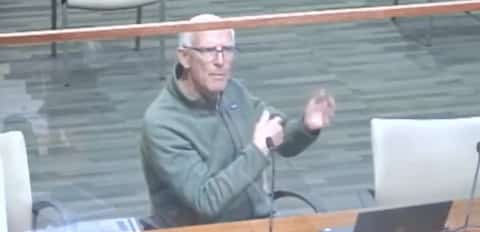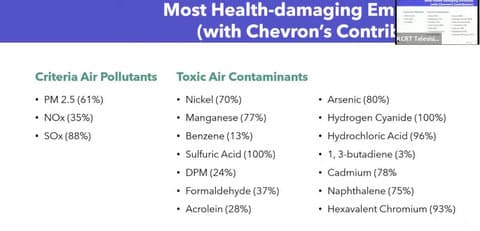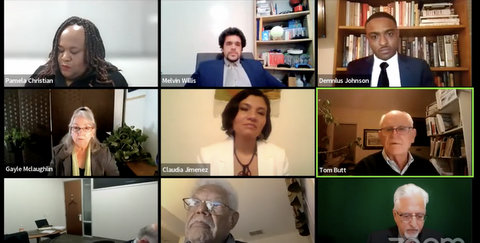
24 May With the Aid of Legislation, Richmond Plans to Hold Polluters Accountable

Bay Area Air Quality Management District steering committee Jeffrey Kilbreth spoke Tuesday at the Richmond City Council meeting. (Screenshot captured by Julia Métraux / The CC Pulse)
By Julia Métraux
As part of California Assembly Bill 617, the most polluted areas across the state were given support and directions to try and limit air pollution in their area. The Richmond-North Richmond-San Pablo region is among those areas.
Bay Area Air Quality Management District community steering committee members Marisol Cantú and Jeffrey Kilbreth gave a presentation of work they are doing as part of AB 617 to the Richmond City Council on Tuesday, including the steps they hope to take going forward.
“Pollution in Richmond has been underestimated and is affecting our health in many different ways, [contributing to] chronic respiratory issues and as well as other cognitive development issues,” Cantú said. “This is data-driven, and we’re holding all of the different polluters accountable as well as regulators.”
One of the major polluters being the Chevron Richmond Refinery. The existence of the refinery in Richmond has long been a subject of contentious debate in the city. Chevron is the largest employer in Richmond, having over 3,000 employees according to data from June 2021. The refinery has also led to significant environmental health issues, both acute and long term. For example, a May 2019 research article published in the Environmental Health journal found that emergency room visits significantly increased in the area for a month following the 2012 refinery fire.
>>>From the Archives: Youth React to Chevron Refinery Disaster
The Chevron Richmond Refinery is a significant contributor of specific toxic air pollutants in Richmond and neighboring areas, according to the presentation. Through modeling, Kilbreth said that the refinery contributes 100% of sulfuric acid and hydrogen cyanide in Richmond’s air, as well as 96% of hydrochloric acid, and other contaminants.
- Kilbreth’s report claims Chevron is a major — and sometimes the only — source of several air pollutants in Richmond. (Screenshot captured by Julia Métraux / The CC Pulse)
“Has the refinery manager of Chevron ever addressed the City Council of Richmond?” Kilbreth asked, which was not directly answered during his presentation. “I don’t recall it ever happening. I would think it would be appropriate.”
Some of the strategies that the Bay Area Air Quality Management District committee members are considering for this project are improving health impact data, strengthening regulation of emissions and increasing accountability for major sources of pollution, like Chevron.
In terms of the timeline for the AB 617 project, Kilbreth said they hope to finish the finalization of strategies by the fall, have Bay Area Air Quality Management District approval between January and March 2024, and have the California Air Resources Board review between April and June 2024.
“You would be in a situation to be reviewing and commenting on them next fall, and that would be very helpful if you would find the time to be able to do that,” Kilbreth said to the City Council.
Council member Soheila Bana asked how AB 617 projects and the council’s support would affect the city of Richmond’s budget.
“The only people who can have a budgetary stake in this are [Bay Area Air Quality Management District] and [California Air Resources Board] and perhaps pollutants’ sources that may be required to do things like reduce pollution,” said Kilbreth in response.
Funds for AB 617 projects were set aside by the California government during the 2017-2018 fiscal year.
During the open comment following the presentation, Richmond resident Jamin Pursell said he hoped the council would continue to take steps to protect both the environment and the effect air pollution has on people in Richmond.
>>>Read: Richmond’s Most Vulnerable Can’t Escape Dangerous Air
“Whether it be the air, whether it be the soil, or the water coming through Richmond, it affects people, not only with their asthma but there are other more subtle ways like perhaps mental health,” he said.
A motion in support of the AB 617 Community Health Protection Program passed 6-0-1, with Bana abstaining, saying she found the wording of the resolution confusing.
The next regular Richmond City Council meeting is scheduled for June 6.
Correction: An earlier version of this story referred to Marisol Cantú and Jeffrey Kilbreth as BAAQMD board members as that is how they were described in the City Council agenda. They are members of a BAAQMD community steering committee.






No Comments